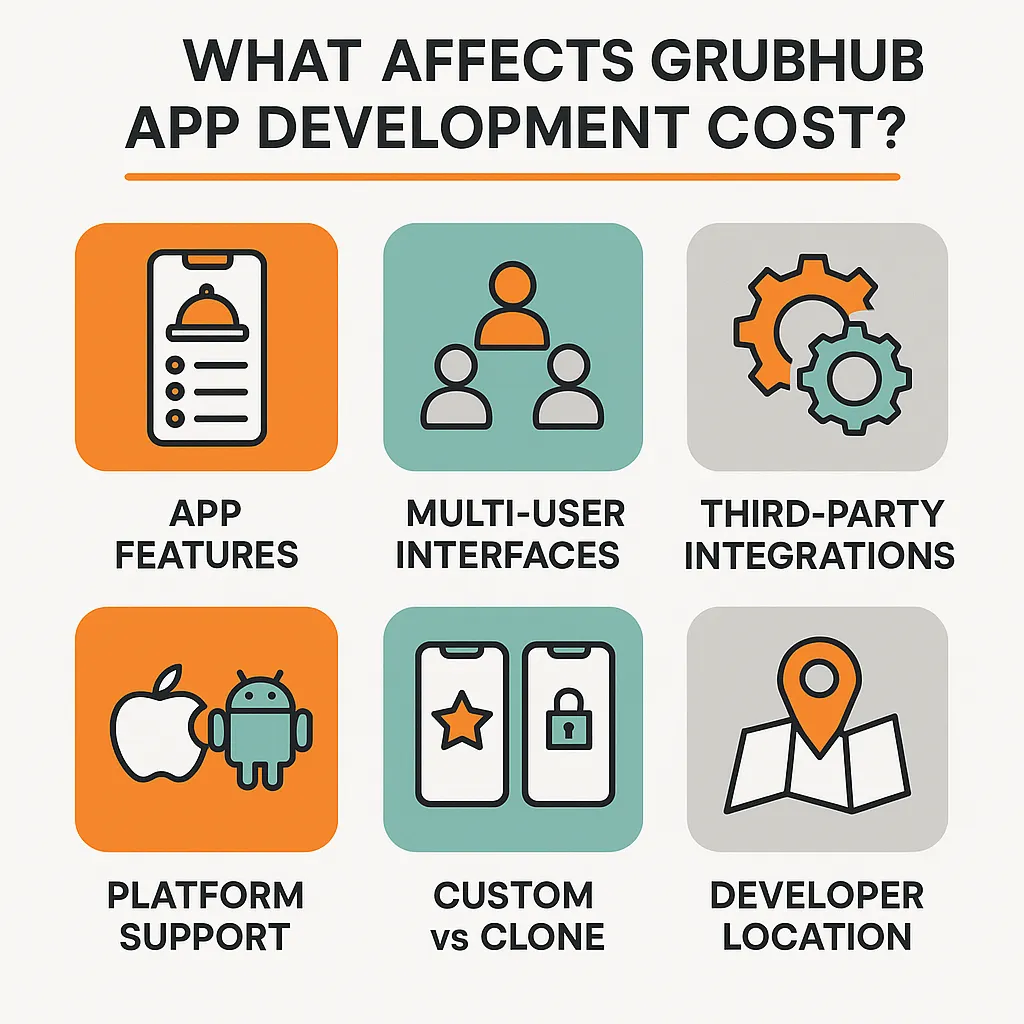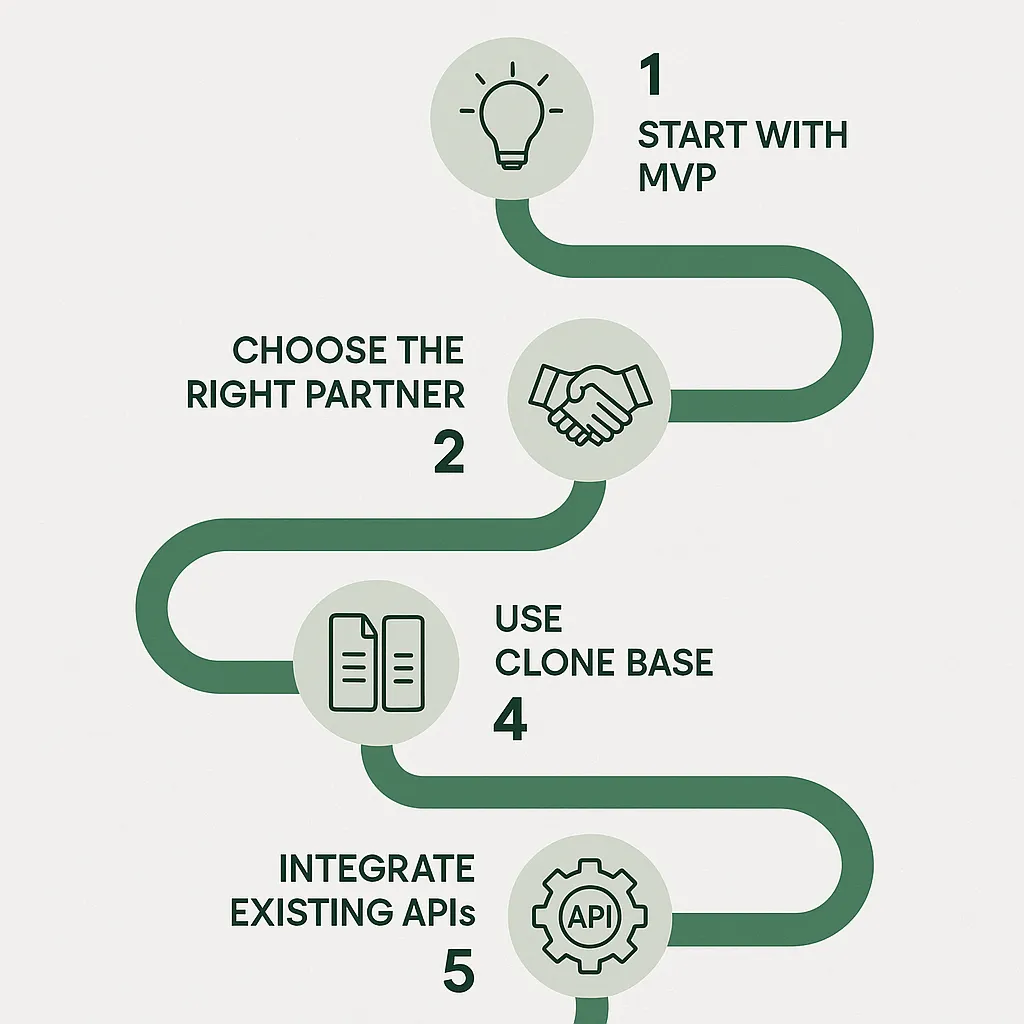Grubhub App Development Cost in 2025 : Full Cost Breakdown
Create a powerful, customizable streaming solution with Miracuves’ Grubhub, equipped with high-performance features and next-gen technology.
Looking to launch your own online food delivery platform like Grubhub? Before diving into UI design or logistics partnerships, one key question matters most:
What’s the real cost to build a Grubhub-style app?
A Grubhub-like app isn’t just a restaurant listing tool — it’s an entire ecosystem of real-time order tracking, restaurant onboarding, delivery logistics, and secure payments. Whether you’re a startup entering the food delivery space or a SaaS founder targeting hyperlocal markets, understanding the Grubhub app development cost is crucial for setting the right budget and expectations.
In this guide, we’ll break down everything cost-driving factors, complexity levels, region-wise estimates, hidden expenses, and smart cost-saving tips — to help you launch confidently and sustainably.

Key Factors That Influence Development Cost
There’s no one-size-fits-all price tag for building a Grubhub-style app. Your final cost will depend on a mix of business goals, feature scope, and technical decisions.
Here’s what affects the budget:
Core Features & App Logic → Features like live order tracking, schedule-based deliveries, menu syncing, and push notifications increase the dev time.
Multi-User Interfaces → You’ll need separate apps or modules for customers, delivery drivers, restaurants, and admins — each with its own logic and design.
Third-Party APIs → Payment gateways, maps, address validation, SMS/email services, and restaurant inventory systems all come with integration time and subscription fees.
Cross-Platform Support → Supporting iOS, Android, and web adds parallel development and testing efforts.
Customization vs. Clone Base → Using a Grubhub clone can save time and money, but may offer limited flexibility compared to a custom-built system.
Scalable Infrastructure → A fast-growing food delivery app needs a cloud-native backend, real-time syncing, and high availability during peak usage.
Developer Location → Rates can vary dramatically by country — with top-tier teams in India or Eastern Europe offering strong value for cost.
Grubhub App Development Cost by App Complexity
To help you plan better, here’s a breakdown of average development costs based on how complex your Grubhub-style platform needs to be.
This includes design, development, testing, and basic post-launch support — but excludes marketing and infrastructure costs.
|
App Type
|
Estimated Cost Range (USD)
|
Description
|
|---|---|---|
|
MVP (Minimum Viable Product)
|
$15,000 – $40,000
|
Basic features such as user profiles, menu listings, simple order placement, payment integration, and basic admin panel. Focuses on getting the app to market quickly for feedback.
|
|
Standard Version
|
$40,000 – $90,000
|
Adds advanced features like search filters, reviews, multiple payment gateways, GPS tracking, and analytics to improve functionality and user engagement.
|
|
Full-Featured App
|
$90,000 – $180,000+
|
Includes high-end features like multi-location support, real-time tracking, AI recommendations, loyalty programs, and robust customer support. Full scalability for growth.
|
Note: These are development-only costs. Marketing, hosting, and compliance expenses are separate.
Miracuves offers flexible packages that let you scale your Grubhub clone as you grow — from MVP to full-featured delivery platform.
Grubhub-Style Food Delivery App Development Cost by Miracuves (2026 Pricing)
To help you plan your budget efficiently, here’s a detailed breakdown of the Grubhub Clone App Development Cost by Miracuves.
These ranges include complete design, backend development, quality testing, and post-launch support. (Note: API integrations, hosting, and marketing are billed separately.)
|
App Type
|
Estimated Cost Range (USD)
|
Description
|
|---|---|---|
|
MVP (Minimum Viable Product)
|
$999 – $1,499
|
Core functionalities like restaurant listing, order placement, payment integration, and tracking — ideal for testing demand and early market validation.
|
|
Standard Version
|
$1,500 – $2,099
|
Adds multi-payment options, GPS tracking, search filters, coupons, and analytics for regional market expansion.
|
|
Full-Featured App
|
$2,899 (Miracuves)
|
Complete Grubhub-style ecosystem (Web + App + Admin) with advanced features like loyalty rewards, AI-powered recommendations, real-time tracking, and scalable admin tools.
|
Note: The cost breakdown reflects Miracuves’ 2025 full-stack app development model.
Every Grubhub-style solution comes with source code ownership, 60-day post-launch support, and free setup on cloud infrastructure.
Launch your Grubhub Clone App in just 3-9 days with Miracuves — built for performance, scalability, and profit.
Average Cost Estimates by Region
Developer location has a direct impact on your project’s budget. Here’s a comparison of what it typically costs to build a Grubhub-like food delivery app depending on where your development team is based:
|
Region
|
Hourly Rate (USD)
|
Typical Cost for Standard App
|
|---|---|---|
|
North America
|
$100 – $200/hr
|
$100,000 – $200,000+
|
|
Western Europe
|
$80 – $150/hr
|
$80,000 – $160,000+
|
|
Eastern Europe
|
$40 – $80/hr
|
$40,000 – $90,000+
|
|
India & Southeast Asia
|
$20 – $50/hr
|
$20,000 – $60,000+
|
Offshore development when handled by experienced product teams can offer significant cost savings without compromising performance or quality.
Cost Breakdown by Development Stage : Grubhub Clone
Understanding where your budget goes during each phase of the development process helps you plan more effectively and avoid unexpected surprises. Here’s how typical Grubhub clone app development costs are distributed across different stages:
|
Development Stage
|
Estimated % of Total Cost
|
Includes
|
|---|---|---|
|
Discovery & Planning
|
5–10%
|
Market research, competitor analysis, defining user personas, feature scoping, technical requirements.
|
|
UI/UX Design
|
10–15%
|
Wireframing, prototyping, responsive design, visual branding, user experience mapping.
|
|
Frontend & Backend Dev
|
40–50%
|
Core feature development, database architecture, APIs, payment integrations, dashboard and logic build.
|
|
Testing & QA
|
10–15%
|
Manual and automated testing, bug fixing, device/browser compatibility checks, performance tuning.
|
|
Deployment & Launch
|
5–10%
|
App store submission (Android/iOS), server setup, production deployment, performance monitoring tools.
|
|
Maintenance & Updates
|
10–20%
|
Post-launch bug fixes, new features, server maintenance, user support, compliance updates.
|

How to Reduce Grubhub App Development Costs (Without Compromising Quality)
Building a competitive food delivery app doesn’t mean you need a massive upfront budget. Here are practical ways to optimize costs smartly:
Start with an MVP → Focus on the core experience: ordering, checkout, and delivery tracking. Expand features once you validate the demand.
Use white-label or clone solutions → Clone apps cut both time and cost, allowing you to launch faster and iterate later.
Choose a specialized partner → Teams with experience in food delivery systems will deliver faster and avoid costly mistakes.
Leverage pre-built APIs → Save backend effort by integrating proven APIs for payments, maps, and messaging.
Build modularly → Develop in phases, so you can upgrade features without rebuilding from scratch.
A lean, phased approach helps conserve cash while giving you the agility to grow and improve your app steadily.
Choose the Right Development Partner
Even with a solid roadmap, launching a food delivery app is a serious undertaking. Choosing the right development partner can determine how efficiently — and successfully — you get to market.
Here’s what to look for in a Grubhub clone development company:
Expertise in food delivery and real-time logistics platforms
Strong portfolio with scalable, multi-role apps
Full-stack capabilities — from planning and design to launch and growth
Understanding of integration needs and cloud-native infrastructure
At Miracuves, we specialize in high-performance, clone-based platforms that help founders get to market faster. Whether you’re targeting a city, region, or international audience, we help you build smart, scale fast, and stay competitive.
Conclusion
The cost to develop a Grubhub-like app in 2025 depends on your goals, features, region, and how you build. From $30,000 MVPs to $250,000+ full-scale platforms, the range is wide — but a smart, modular plan makes it easier to manage both quality and budget.
Ready to build your food delivery platform?
Talk to Miracuves today for a personalized estimate and launch strategy tailored to your vision.
For more guides on food delivery clones, logistics tech, and app marketing, explore our full app development series.
Frequently Asked Questions
Building a custom Grubhub-style app can cost $30,000 to $250,000+.
With Miracuves’ ready-made Grubhub Clone Solution, you can launch in just 3–9 days for only $2,899, including setup and deployment.
Yes. Clone solutions offer faster time-to-market and lower upfront costs, especially for startups testing new markets.
Traditionally, developing an MVP takes 3–4 months, and a full-featured app may require 6–9 months.
With Miracuves’ ready-made Grubhub Clone Solution, you can launch your app in just 3–9 days — complete with setup, customization, and deployment.
To maximize reach, you’ll want to support iOS, Android, and Web — either through native or cross-platform development.
Building a custom Grubhub-style app can cost $30,000 to $250,000+.
With Miracuves’ ready-made Grubhub Clone Solution, you can launch in just 3–9 days for only $2,899, including setup and deployment.



